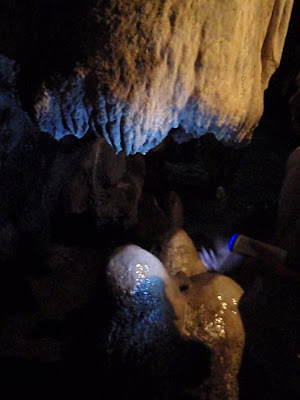After checking the Daraga Church here, we proceeded to Hoyop-Hoyopan Cave in Camalig, Albay. Its about 15 km. from Legazpi City, and 15-20 minutes drive.
We passed well-paved roads with views of rice fields and a lot of trees, mostly the pili trees, where their famous pili nut come from. Our van driver also pointed to us the planned site for the bigger Legazpi airport in a large rice field. A few minutes later, we turned left on this fork on the road.
The Bicolano term "hoyop-hoyop" means "blow-blow", which is very apt to the name of the cave we visited. The interior of the cave is cool and well-ventilated, due to the breeze that pass through its more than 4 entry/exit points on the hillside. When the wind is strong, our guide says that you could hear whistling sounds created by the wind inside the cave network.
The cave network is privately-owned by 3 families in the area. It has 3 levels, but the owners only allow exploration to the second level due to safety concerns.
Our guide oriented us first between the difference of stalactites (ceiling formations) and stalagmites (formations on the floor). These limestone formations take hundreds to thousands of years to develop, depending on the frequency of water droplets from the cave ceiling.
If you will enhance your imagination, some formations resemble animal shapes, human figure, and religious images. Since this cave is usually visited by people, we only saw a few bats inside, so there is no bad smelling guano (bat dung).
The guide brought us to a mini-lake formation inside the cave. Above it is where the late Paquito Diaz sat on his throne as the devil on the Ramon Revilla film's "Lumaban ka Satanas". The water on this lake is pure naturally-produced mineral water from stalactite droppings.
Here's our first exit point after squeezing ourselves out of a narrow passageway. Then, we went down on a trail to a short upward hike on a second cave entrance which is wide and airy.
Behind the right side of this cave entrance, the guide showed us a fossilized human bone, embedded on the cave's wall below. This further supports the belief that early Filipinos have used the cave as their shelter, as some archaeological artifacts dating from 50 B.C. were excavated on this cave by a Franciscan priest, and were now housed in the National Museum and nearby Camalig church.
A hole on the cave ceiling near the second entrance, probably a source of gushing water inside the cave during heavy rains. Near this spot is a large stalactite formation resembling a hand, but my photo quality is not good on that spot due to lack of lighting.
There are portions of the cave wherein crystals form, usually on the cave's walls, not from stalactites. Below are 2 of those samples where crystals start to form.
Can you see the round dance floor on the photo below? It was built by the cave's owners, since they also use the cave for private functions, especially during the martial law years. On the left side is a grotto-like formation, and on the upper right side is a formation that resembles an angel's wing. A fossilized coral stone is also inside this chamber, an evidence that the whole Philippine archipelago rose up from the ocean millions of years ago.
The second exit point we used.
Before leaving the area, I paid the cave's owners with Php 300, their fee for any group in touring the cave with electrical lights on. The kids bought a few crystal key chains from the tour guide, before I gave him a tip. According to the tour guide-crystal vendor, they get these crystals from the nearby Calabidongan cave, which is a much bigger network, but difficult to traverse because of deep pools of water.
The kids enjoyed this unique and educational experience. See this cave when you're just within Daraga or Legazpi City.





















No comments:
Post a Comment